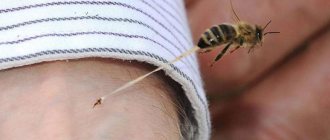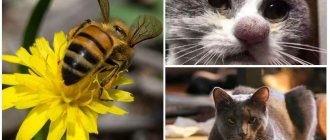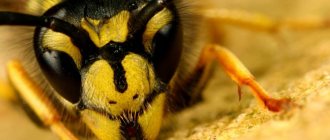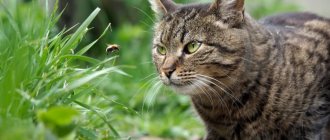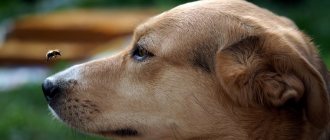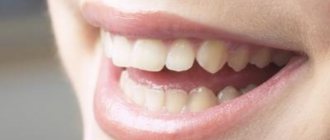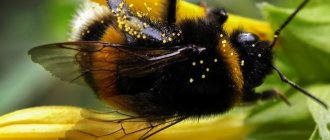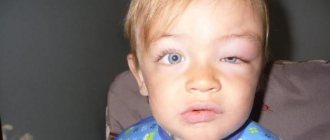A bee is a quite useful insect that produces wax, honey, and propolis. However, despite its benefits, many people are afraid of it. The reason for this is a bee sting.
Bees are not the only insects that bite humans. There are many others that harm humans, such as wasps, bumblebees, house ants, cockroaches and bedbugs. But today we will talk about bees.
To prevent undesirable consequences after a bee sting, you need to have an idea of how dangerous it is, what the body’s reactions may be and how to act in such a situation.
Bite symptoms
- Instant, sharp pain (often with a throbbing burning sensation), concentrated mainly at the site of the bite.
- A protruding black sting in a tiny bag of poison.
- Localized redness appears (no more than 10 cm in diameter), and after half an hour severe itching appears.
- The area of skin or the entire affected area becomes very swollen, with peak swelling occurring within 48-72 hours.
- Swelling of the stung area. For allergy sufferers, symptoms can worsen greatly, as swelling of the mucous membranes, breathing problems, and changes in heart rate may appear.
Providing first aid for a bee sting
- It’s good to examine the site of the bite; it looks like a bright pink papule with a bee sting in the middle. If you do not observe it, then most likely it has gone deeper into the wound; it may also be that you were bitten by a wasp, and it does not leave a sting in the victim.
- The sting should be removed from the skin. If you have slightly overgrown nails, you can remove them, but preferably with tweezers. If the sting remains in the skin, it must be squeezed out; you must squeeze until you see drops of blood, in which case some of the poison will come out.
- You should go over the bite site with a cotton pad that has been previously moistened with an antiseptic. Any remedy will do - chlorhexidine, hydrogen peroxide, iodine or brilliant green.
- Next you need to apply cold. You can use frozen meat from the freezer, but first you need to wrap it in a clean cotton towel.
- It is important to treat the stung area of skin with a local antihistamine, this can be Fenistil in the form of a gel or Psilo-balm.
- You should also be sure to take an antihistamine. This measure of necessary assistance, especially if an overly active reaction of the body occurs (rash, huge swelling, suffocation, etc.), including if the victim is prone to allergies, as well as in children under 12 years of age.
We advise giving a person stung by a bee plenty of fluids - water, sweet tea, compote. This is done in order to reduce the concentration of poison in the human body and speed up its elimination.
Note! If a bee has bitten you in the eye, then you cannot do without an ambulance; you must first complete the entire first aid algorithm.
Prevention
To avoid bee stings, you need to follow simple recommendations:
- If a bee flies very close, you should not try to drive it away. It is important to remain calm and not make sudden movements until the insect flies away.
- Experts do not advise being afraid of bees. Many scientists claim that insects sense how adrenaline is produced.
- Don't wear bright clothes that attract bees.
- It is not recommended to use perfumes and deodorants that have strong odors. They attract insects.
- You should not walk barefoot on the grass.
Bee stings can pose a real danger to human health and life. Therefore, it is important to provide first aid to the victim in a timely manner. If allergy symptoms appear, a person must be immediately taken to a medical facility.
What to do if a child is bitten by a bee
With young children (under 10 years old), it is important to be more careful, as a bite can turn into an allergy to bee venom. The harmful effects of a bite are also due to the fact that a child’s body weight is much smaller than an adult’s, so the toxic effect of the poison is more pronounced.
If the bite is located near the mouth, throat or eyes, you should immediately call an ambulance. It is recommended to remove the sting from the baby's skin as soon as possible.
If a child is bitten by a bee on a limb, arm or leg, then the consequences are much simpler, so you can stop the consequences yourself.
What to do if a bee stings your hand?
- First of all, you need to give your child plenty of drink (teas, compotes or juices).
- Remove the sting. And reduce the rate of spread of poison throughout the body by contacting the stung area with cold.
- It is important to explain to the child that it is forbidden to scratch the bitten area. If the baby is still very small, then you will have to make sure that he does not scratch.
- It is necessary to give antihistamines in the dosage recommended by the manufacturer (Tavigil or Suprostin), cream or ointment, for example, Finistil.
How to remove a tumor if bitten by a bee, folk remedies:
- Plantain leaf.
- A piece of onion, garlic.
- Soda with water.
Harm and benefits of bee venom
It is believed that humans receive nutrients through insect secretions. Doctors call this process bee apitherapy. The poison has a complex composition:
- sulfur;
- manganese;
- stearins;
- amino acid enzymes;
- nitrogen;
- fructose;
- glucose;
- phosphorus;
- iodine;
- chlorine.
The set of substances in bee secretions is similar in composition to the components of a strong antibiotic. They retain their antibacterial effect throughout the duration of the poison's action, even after the death of the insect.
Interesting! Scientists noted that the secret can be used to create new drugs. The components of bee venom remain sterile for several days. The substance can be diluted to a ratio of 5000:1 without loss of benefit. Therefore, despite the tiny dose, it remains useful and effective for humans.
Read more about the benefits of bee venom for humans in this article.
Bee secretion has the following features:
- destroys E. coli;
- kills staphylococci, streptococci;
- diphtheria pathogens will be destroyed from exposure;
- bacteria and viruses die.
The mechanism of action of the poison is not lost even when water is heated to the boiling point. It has a strengthening effect on the human body, increasing immunity. It also dilates blood vessels and enhances the diuretic effect. When blood thins, blood pressure normalizes and hemoglobin levels increase. In some medicines, bee venom is needed to reduce fever in children and adults and improve metabolism.
Despite its benefits, bee venom has one significant drawback. It is contraindicated for people diagnosed with individual intolerance. In such cases, you don’t have to be afraid of only males, since drones don’t bite. Worker bees sting and have a long nose. Males cannot provide themselves with food; they live only at the expense of the worker colony.
Negative effects of bee vinegars:
| Power of defeat | Manifestation | Complications |
| Lightweight | Destruction of red blood cells | Heavy bleeding |
| Weak, average | Disturbance of the composition of nerve cells | Atrophic effects on the central nervous system |
| Strong | Weakness, vomiting, rash, loss of consciousness | Respiratory arrest, death |
Bee stings pose the greatest danger to children. Children of preschool age from 2 to 6-7 years remain at risk. Most often, bites occur in the mucous membranes: lips, eyes, nose. Painful insect stings can cause the membranes to expand. For example, a bite to the tongue is accompanied by swelling of the organ, after which the airways become blocked. If emergency medical care is not provided, asphyxia occurs.
How to help a dog stung by a bee
The first step is to understand where the bee bit the dog, then disinfect the tweezers and remove the sting.
Then perform the following actions:
- Gently wash the bite area with clean distilled water or baby soap. Only in this case it is important to try not to make soap into the wound itself.
- Give the injured pet an antihistamine; it can be bought at a veterinary pharmacy, but some dog breeders say that human antihistamines can also be given.
- The wound from which you removed the insect sting should be poured with hydrogen peroxide, and excess peroxide should be absorbed with paper towels.
- Next, the punk needs to be anointed with anti-itching ointment, for example, Tavegil.
- Then apply a cold compress to the stung area of skin for 20 minutes, with short breaks, so that the cold does not freeze the dog too much.
- If swelling is severe, it is appropriate to give your dog a diuretic (such as Lasix or Ugeril).
- It is advisable to lighten the dog’s diet for 3-4 days and replace the usual diet with lighter foods. This is necessary so that the body fights the poison, and does not waste energy on digesting heavy food.
- It is important to provide your dog with constant access to clean drinking water.
This algorithm of action can also be applied if a bee has bitten a cat.
Important! Try to closely monitor the condition and health of your pet for the first 24 hours after the bite. If alarming symptoms appear: hoarse breathing, cough, rash or severe swelling, then you should immediately take your dog to a veterinary clinic for qualified assistance.
Folk remedies
If you don’t have pharmaceutical drugs at hand, you can use one of the folk remedies:
Parsley
Chop the parsley and pour boiling water over it. After cooling, apply the leaves to the bite site to relieve inflammation and swelling. To enhance the effect, combine parsley pulp with chopped plantain leaves.
Mint and lemon balm
These medicinal herbs contain essential oils that not only help with bee stings but also repel insects. If you crush the leaves in your hands and rub them on your body, the bees will not come close to you.
Natural olive oil
Lubricate the wound with it several times every 10 - 15 minutes. This will relieve inflammation and swelling, eliminate redness on the skin.
Plantain
Wash the freshly picked leaf, mash it slightly until the juice releases and apply to the bite site.
Aloe
Cut the leaf and apply it to the wound. Aloe juice disinfects wounds, relieves swelling, and reduces pain.
Onion
Grate the onion and apply the paste to the bite.
Emergency help for allergy sufferers
For people with a tendency to allergies, bee stings pose a mortal danger, so the victim should not be left alone until the ambulance arrives. It is urgent to give an antiallergic injection and carefully monitor the person’s condition.
- If cardiac arrest occurs, resuscitation measures are used: indirect cardiac massage and artificial respiration . For 30 compressions in the chest area, take two breaths. You need to press with straight hands, without much effort, so as not to break the ribs and sternum. Such damage will make breathing difficult and lead to negative consequences.
- It is better to replace mouth-to-mouth artificial respiration with mouth-to-nose breathing . If there is swelling, the tongue sinks, so air will not get into the lungs. The correct ventilation of the respiratory system is checked by changes in chest volume.
Video tips for emergency help for allergy sufferers
Consequences of a bee sting
For many people, the swelling and swelling subsides within 2-.5 hours - the most important thing here is not to scratch the damaged area. But for about 1 percent of people, bee stings cause dangerous consequences.
Anaphylaxis is a dangerous allergic reaction that threatens the life of the victim. Its symptoms are as follows:
- The neck and larynx swell terribly;
- Breathing becomes difficult - it noticeably quickens, it is difficult to breathe, sometimes even wheezing appears;
- Blood pressure drops rapidly, and the pulse becomes threadlike;
- Dizziness, signs of nausea may appear;
- The victim loses consciousness.
If anaphylactic juice appears, then you need to immediately call an ambulance, since it will not be possible to cope without experienced doctors.
Classification
Bee stings can be single or multiple. In the first case, sharp and burning pain occurs in the affected area. You can also see that the area is swollen and red. Multiple bites are considered more dangerous. They pose a real threat even to people who do not have allergies.
Also, stings are classified depending on the type of bee. Thus, people are bitten by both domestic and wild insects. It is worth noting that in the second case the risk of developing allergies is significantly higher.
How to Avoid a Bee Sting
To avoid becoming a victim of a bee, you should follow some rules:
- Eat sweets and fruits carefully and attentively, especially in nature.
- If you are going on vacation in the fresh air, choose neutral colors of clothing.
- A hat and clothing covering arms and legs protects against suspected bites.
- You should not smell of perfume, deodorant, cigarettes, alcohol or gasoline, as these odors greatly anger the bees.
- You should be especially careful when walking in open shoes when meadows and herbs are in bloom.
- The bees' anger only intensifies with sharp swings of their hands, so if the bee had no intention of stinging you before, then your swings may change its mind. This recommendation applies to all flying and biting insects.
- There is no need to disturb the hive and approach them less than 3 meters.
- You need to treat yourself with products that will repel insects.
- When caring for an apiary, it is important to use protective equipment.
We hope you found this article helpful. Remember that if a severe allergic reaction is observed after a bite, you should immediately call an ambulance. All the best!
A bit of Wikipedia
Honey bee (Apidae)
A bee (lat. Anthophila) is a flying insect from the order Hymenoptera. At the moment, more than 21 thousand species of bees have been identified and described. They are found everywhere except Antarctica, which is logical. Bees feed on nectar and pollen. They have the property of eusociality - a certain form of organization of communities of animals and insects, in which some individuals do not participate in the reproduction process, but are busy obtaining food and protecting the group.
In our latitudes, honey bees, members of the family “True bees” (Apidae), predominate. Bees play a vital role for the ecosystem and humans in particular, pollinating various plants. “If bees suddenly disappear, then after four years man will disappear too” - these are not my words, Einstein said them (but there is another, more boring, version of the origin of this phrase).
